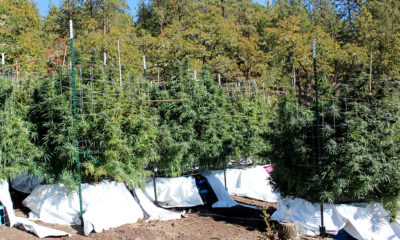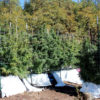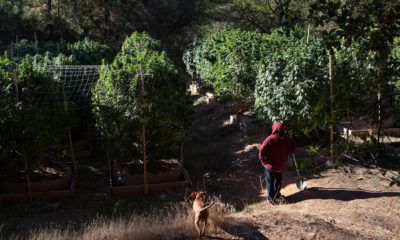
Cultivation
Years of Underground Cannabis Research Ready to Rock the Boat
With the passage of California’s Medical Marijuana Regulation and Safety Act (MMRSA) and the subsequent passage of local regulation – some growers are eager and poised to become professionals.
Humboldt County within the Emerald Triangle has long been synonymous with the world’s best cannabis. We’ve all heard of the regions pioneering growers. Almost taking on mythical status in cannabis folklore, Northern California’s cannabis farmers have been depicted as counter culture outsiders who bock at the plant’s recent normalization.
Topically lucid, most rooted growers simply seek return for investing years of hard work. Many growers have stockpiled intellectual capital – knowledge of optimal growing conditions, premium strains, breeding techniques, cures for pests and diseases and so on. A plethora of cannabis expertise exists in this region. Yet most have been reluctant to share their information for fear of government reprisal or competitive appropriation. Without support from the government, security and patent protections are obsolete. If growers openly share their intellectual capital, it would be easy to abscond their lifetime’s work. This is why Emerald cannabis farmers remain underground.
That is, until now.
With the passage of California’s Medical Marijuana Regulation and Safety Act (MMRSA) and the subsequent passage of local regulation – some growers are eager and poised to become professionals. Over decades of cultivating cannabis, farmers have turned unique knowledge into specialized skills. Epitomizing this crop of specialized professionals is a hidden gem within the Emerald Triangle: a scientific research group called Humboldt DNA. This team of scientists is on the verge of identifying and mitigating one or more infectious agents within the cannabis cultivar. And only recently, due to support from local government and community, are they ready to come into the light.
According Humboldt DNA’s founder, “we weren’t ready to take this public but if the county will embrace us as being business people and professionals than we’re going to be business people and professionals.”
Humboldt DNA’s story goes like this: long before powdery mildew and spider mites, cannabis seemed easier to grow. Humboldt’s renowned cannabis strains seemed to once have more vitality. Over the years, plants were loosing vigor. For Humboldt DNA, this failure to reach full potential was a problem. Humboldt DNA’s passion for the plant emboldened them to figure out why. They tested every pest management application they could get their hands on – “testing all angles” as Humboldt DNA’s lead scientist put it. While developing control methods for classic pests and mildews, they observed a range of specific symptoms unresponsive to treatments, which were hindering an appreciable percentage of their plants.
They dug deeper. They began to look outside of their own plant stock and what they witnessed was frightening. The symptoms they observed in their nursery were also affecting other grow rooms in the area. Most alarming, they observed these symptoms were more or less doubling year after year. If not stopped this outbreak would soon affect all medicinal cannabis plants within the region, potentially leading to massive failure. Humboldt DNA realized this was (and still is) a major problem.
Humboldt DNA’s founder assembled a secret research team. Made up of a half dozen PhD’s, dozens of farmers, nurserymen, and industry professionals, their goal was to solve the outbreak of what they now term: Putative Cannabis Infectious Agent(s) (PCIA). Strong evidence and theory leads them to believe that they are dealing with one or more viruses, although additional research is needed for conformation.
Through years of testing they determined that PCIA is seed and pollen born – it is passed on through pollination and cloning. It is vectored by insects – such as aphids, root aphids, mites, thrips and white flies. They have ruled out fungi, oomycota, bacterial causes, as well as genetic drift – i.e. somaclonal variation. PCIA never leaves the plant; there are no accidental immunities or anomalies where a plant doesn’t contract the infectious agents from a parent plant. They have also discovered the mechanism by which PCIA inhibits plant growth.
They also believe they have found a solution.
Humboldt DNA “boldly predicts that [they] will pull PCIA from cannabis plants and the results will be staggering – we will see a resurgence of genetic vitality that hasn’t been seen for decades.”
This group is also tied to community. “We’re in Humboldt and Humboldt should own this… we will operate in an area where we raise the entire bar – we will grow the best – we will come out the gate, out of rec (legalization of recreational cannabis), miles ahead.”
Humboldt DNA intends on building facilities across Humboldt County, starting with a laboratory in the city of Arcata’s yet to be created Medical Marijuana Innovation Zone (MMIZ). They intend to push the Humboldt brand to new heights. They predict that the whole world will not only seek genetics from the area but it will become mandatory to source genetics from Humboldt. Their technology will stay proprietary and they are committed to staying in the Emerald Triangle – that means the money will stay in the community.
Humboldt DNA has identified six social groups that will benefit from their pioneering venture.
Cannabis farmers will benefit from improved harvests – with higher yields and higher quality due to uninfected plant stock. Environmentalists will see fewer impacts from pesticides, fertilizers, and fungicides – as uninfected clones and seeds will greatly reduce the need for these applications. Enforcement agencies will benefit because Humboldt DNA’s genetics will only be available to compliant cultivators – this will create a natural incentive for growers to stay up to code. Academia will benefit from the value of numerous research opportunities, charting a cultivar from its infancy – a huge body of epistemological knowledge. Patients will benefit from higher quality, cleaner medicine. The government will benefit from increased revenue due to increased productivity. It’s a win-win and as Humboldt DNA’s founder put it, “the only losers are viruses and companies that sell poison.”
This group wasn’t ready to leave their covert lab but recent developments gave them confidence to make the leap. Humboldt DNA is ready to transition into a fully legitimate business. As their founder confided, “when you have the (Humboldt) planning commission and board of supervisors taking decisive action like they have, and you have someone like me, running a secret research group in the basement, who cannot do what he needs to do to solve this problem, it creates incentive to come into the (public) light.”
The embrace of local government and community has created an opportunity for Humboldt DNA to venture out of the dark. They are pioneers in a new industry. They are an example of the potential of California’s cannabis industry. They are industry leaders. But most of all they are community members. We can only hope that more will follow their footsteps.
What do you think? Does research like this indicate growers may increasingly come forward to share information?























